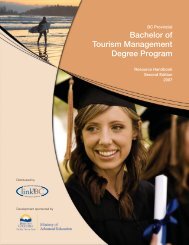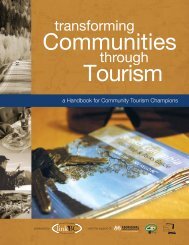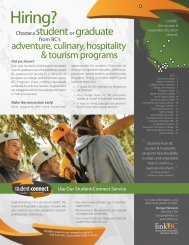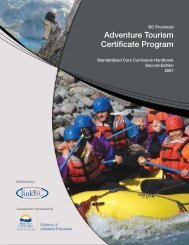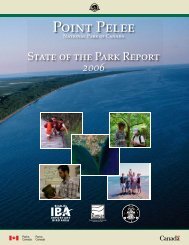Cultural Heritage Tourism Handbook - LinkBC
Cultural Heritage Tourism Handbook - LinkBC
Cultural Heritage Tourism Handbook - LinkBC
- No tags were found...
Create successful ePaper yourself
Turn your PDF publications into a flip-book with our unique Google optimized e-Paper software.
Ten Tips for Developing <strong>Cultural</strong>/<strong>Heritage</strong> <strong>Tourism</strong> Experiences5.3 Assess Your Potential (Baseline Surveys & Inventory)Once a cultural/heritage tourism task force or advisory group is established, a number of steps andtools can be used to help develop the strategy.1. Incorporate as much local flavour as possible in your product offerings—sharelocal foods and wines, showcase your best local talent, etc.2. Make it easy for visitors to find and enjoy what the locals know.3. Provide exclusive opportunities—for example “backstage passes”—something not available to everyone.4. Develop “hidden gems”—unique opportunities to meet and interactwith local enthusiasts to provide entertainment, to learn, or to immersevisitors in the lifestyle and landscape of your destination.5. Recognize you’re now in the business of crafting “great story”moments. Make sure your offerings are story-worthy. Ensure visitors willbe excited about sharing their experience with friends and family.To assess your community’s potential for cultural/heritage tourism,you need to:• Understand the wider tourism supply system in your region,province or territory.• Gauge how receptive residents might be to tourism.• Understand what visitors are seeking.Assess Your Potential in Three StepsAs a group, ask yourself these three questions:1. What’s possible with our natural and cultural resources?2. What’s appropriate or desired in our community?3. What’s economically sustainable?The state of Arizona has been a leader in cultural/heritage tourismdevelopment for more than a decade, with its “sunbelt” amenitiesand growth. They believe that for a community to be ready forcultural/heritage tourists, three essential elements are required 36 :1. The presence (an ‘inventory’) of developed or developingcultural/heritage sites, attractions, and resources.2. The willingness of the public and private sectors to worktogether to maximize the quality of the historic inventory,as well as the quality of services and amenities needed bythe cultural/heritage tourist.3. The interest of a specific, and lucrative, visitor market for theproducts and experiences you plan to offer.You need to determine whether your community has the capacityto move forward, the desire to proceed, and products that line upwith the demands of the marketplace (often called product-marketmatching).6. Provide a hands-on and interactive experience. Don’t underestimatethe value visitors find in activities locals might take for granted.7. Be innovative and don’t be afraid to take chances.8. Work with your competitors, better known as your allies, in attractingvisitors to your destination. Give your visitors tips on what to see and donearby, and where to eat. Consider packaging your offerings and make iteasy for potential visitors to buy.1. CapabilityWhat have we got?(what’s possible with our naturaland cultural resources?)2. SuitabilityWhat will we share?(what’s appropriate or desired inour community?)3. FeasibilityWhat do our guests want?(what’s economicallysustainable?)Obtaining answers to these questions through the three steps above will help your community chart the right course ahead.9. Think about how you can provide “only available here” activities to setthe stage for a great story to happen.10. Include something unexpected or an element of surprise, perhapsa take-away locally-produced gift. These small things add value andenhance the overall visitor experience.– Department of Economicand Rural Development and <strong>Tourism</strong>, Nova ScotiaEssential Element: An InventoryThere are a number of ways to complete an inventory of yourassets in tourism and culture, ranging from complex GIS computermapping to simple brainstormed lists. Complex methods are nota requirement. Your group will want to capture information aboutall the (arts, culture and heritage) resources in your community, aswell as all the (tourism) businesses, organizations and agencies thatprovide the goods and services visitors need.Look on the <strong>LinkBC</strong> <strong>Tourism</strong> Online Resource Centre for simpleinventory checklists from New Zealand (www.torc-ttracanada.ca –search “Checklists” “New Zealand”). Should you have access to GIS,the methods for a tourism inventory developed in BC are at www.ilmb.gov.bc.ca/risc/pubs/culture/cstos/assets/digdat_tos.pdf .A culture-specific inventory is covered in the <strong>Cultural</strong> Mapping and<strong>Cultural</strong> Planning Toolkits of the Creative City Network of Canada .This two-step process has communities map out what is importantto their culture, and then develop a plan on how to manage thoseresources sustainably.The next few pages provide checklists you can use to assess yourcommunity’s cultural/heritage tourism capacity.36 37



